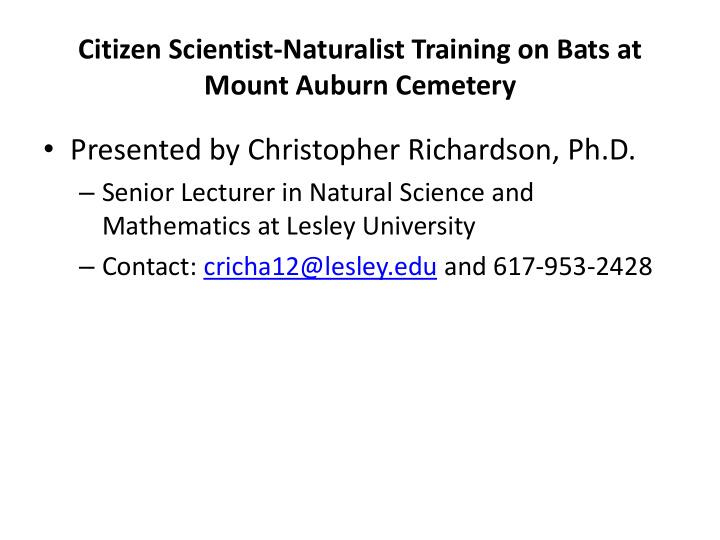



Citizen Scientist-Naturalist Training on Bats at Mount Auburn Cemetery • Presented by Christopher Richardson, Ph.D. – Senior Lecturer in Natural Science and Mathematics at Lesley University – Contact: cricha12@lesley.edu and 617-953-2428
What are bats? • Bats are mammals of the order Chiroptera • Forelimbs form webbed wings, making them the only mammals naturally capable of true and sustained flight. • Second largest order of mammals • The less specialized and largely fruit-eating megabats, or flying foxes, and the highly specialized and echolocating microbats • About 70% of bat species are insectivores. Most of the rest are frugivores, or fruit eaters. A few species, such as the fish-eating bat, feed from animals other than insects, with the vampire bats being hematophagous, or feeding on blood.
Giant golden- crowned flying fox, Acerodon jubatus (source: Wikipedia)
Myotis lucifugus (the little brown myotis) • Photo by Thomas Kunz
What do bats do? • Bats are present throughout most of the world, performing vital ecological roles of pollinating flowers and dispersing fruit seeds. • Many tropical plant species depend entirely on bats for the distribution of their seeds. • Bats are economically important, as they consume insect pests, reducing the need for pesticides.
Why study bats? • In general, bats are ideal models for investigating factors related to variation in BMR • Bats are facultative endotherms that are capable of physiological temperature regulation, but they do not consistently maintain an elevated body temperature. • Seasonally, heterothermic temperate bats like E. fuscus and M. lucifugus , which hibernate , experience physiological changes due to changes in hormone levels and energy use for maintenance metabolism, reproduction, immune function and thermoregulation • When including the effects of flight and reproductive changes like pregnancy, the range of physiological and metabolic changes that a small temperate zone bat like E. fuscus and M. lucifugus undergoes is great • Making it a useful species for the study of studying variability in metabolic rate and related physiological variables including immune function and response to diseases like white
Urban Wildlife Refuges 80% of the world’s population currently living in urban areas Models for successful urban wildlife refuges are desperately needed Cemeteries are an overlooked potential wildlife refuge common to most citie s
Mount Auburn Cemetery 175-acre site “Silent City” : 98,000 people buried or commemorated Founders envisioned it as a garden cemetery Unique and iconic urban ecosystem Commitment to sustainability
Biodiversity survey: Bats - Acoustic detection - Mist netting - Identifying flight corridors
Mist Net • Photo by Bat Conservation and Management
Harp Trap • Photo by Bat Conservation and Management
Evidence of bats at Mt Auburn Cemetery • Big brown bat : acoustic detection, visual confirmation, live capture • Eastern red bat : acoustic detection, visual confirmation • Hoary bat : acoustic detection • Little brown myotis : acoustic results
eastern red bat ( Lasiurus borealis )
Hoary Bat ( Lasiurus cinereus )
White-Nose Syndrome • Millions of bats have died since 2007. • A fungus, Pseudogymnoascus destructans , is the cause. • The following pictures show its impact at an important hibernaculum in Vermont. • WNS Research done in Thomas Kunz lab by Jon Reichard, Marianne Moore, Nate Fuller and me (Biology Department, Boston University)
Mt. Aeolus, Vermont
Mt. Aeolus, Vermont
Ecological Immunology • Examines the underlying causes of variation in immune function between individuals or populations • Examines life history trade offs • Costs of Immunity • Role of Environment: Impact of Urbanization ? • Trade offs among immune components
Recommend
More recommend